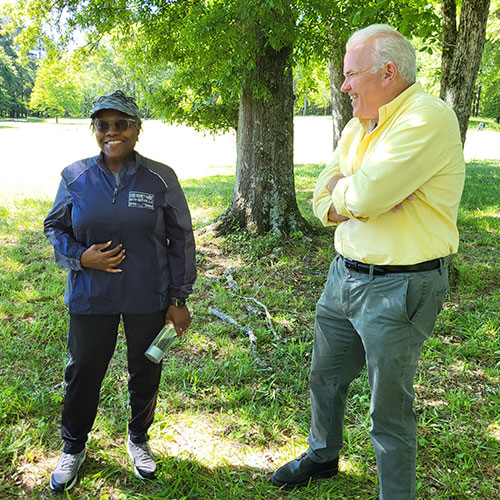For Terrance Weik, the gravesite of his great-grandmother was a sacred place: her headstone memorialized a place where he could remember her and those who came before.
His heart was broken the day he arrived at the cemetery and found that nearly half of her small burial marker had been removed. Little was left to mark her final resting place. Similarly, his great-great-great-grandmother’s grave marker lay face down, split in half in an overgrown portion of another cemetery.
Weik, a USC archaeologist and professor of anthropology, experienced firsthand the focus of his ongoing research project: the erasure of Black burial grounds and cemeteries. He says this is all too common for Black communities whose cemeteries get neglected or redeveloped, an issue that goes deeper than just the physical markers.
“Death is a heavy thing,” Weik says, “but in many communities, our ancestors are continuous members of our community. We engage with them through acts of respect, offering, prayer and other practices.”
Acknowledging injustices
Weik is working on research and preservation efforts at three burial grounds across South Carolina: sites in Blythewood, Daufuskie Island and Hilton Head.
These areas are facing rapid development, making them priorities for preservation efforts.
Through a 2021 Racial Justice and Equity Research Fund grant from USC’s Office of the Vice President for Research, Weik began investigating the effects of dispossession on people in South Carolina’s Lowcountry.
Along with USC’s Eric Jones, an associate professor of anthropology, Weik examined how Black communities, like the Gullah-Geechee people, have been removed from their cultural centers in Hilton Head due to tourism-driven development.
There's so much you can learn from a cemetery in terms of the names, dates of birth and death. Sometimes, beliefs and values are depicted symbolically on gravestones.
Weik says the continued separation from their own history perpetuates the dispossession of African Americans and further distances them from reclaiming cultural traditions of their ancestors.
“Being disconnected from our ancestors is a type of violence,” Weik says.
The burial grounds in Hilton Head and Daufuskie are important repositories of knowledge about genealogy, identity and history.
“There's so much you can learn from a cemetery in terms of the names, dates of birth
and death. Sometimes, beliefs and values are depicted symbolically on gravestones,”
Weik says.
Weik and Jones work with descendants of people buried at these sites, giving them
an opportunity to help shape the goals of the project.
This community-minded approach also led Weik to the Blythewood cemetery, where descendants asked for his help.
Rebuilding community and family ties
Weik is working with Cynthia Green and Charlie Smith to study and preserve a burial ground on property that once belonged to John Herman Kinsler.
Through researching their family trees, Green and Smith learned that they share an ancestor in Kinsler, a plantation owner and enslaver in 19th-century Richland County.
Green says visiting the site has been an emotional experience and a way to connect with family, both living and long passed.

“It’s a spiritual thing. I feel connected to these people,” Green says. “It feels like we’re bringing the family back together.”
Green and Smith are using what they know of their family histories to help Weik narrow down who might be buried in that small cemetery.
Before that, though, Weik must work out the physical parameters of the burial grounds. Using precise surveying equipment, Weik and his graduate assistant Angelina Towery-Tomasura are mapping the site.
Eventually, Weik hopes to use ground-penetrating radar to find where and how many remains are at the site. This technique would allow them to gather information without disturbing or damaging the remains.
Weik is leaning into relationships with local leadership at the other burial locations he’s investigating. On Daufuskie Island, Weik is partnering with a famous local figure, Chef Sallie Anne Robinson, a sixth-generation native of the island with deep roots in Gullah culture.
Projects like Weik’s could get a boost from the African American Burial Grounds Preservation Act, passed by Congress in 2022. The new law makes federal grants available for identifying, preserving and restoring African American burial grounds.
“It’s one way we can reach back and be stewards of the people, material culture and the places that we work with,” he says.
Weik’s primary goal in this research is to give descendants opportunities to connect with their ancestors and take part in research questions and project-building.
“I’ve had a strong interest in issues of cultural practices and African connections,” Weik says. “Of all the things you could study and investigate, burial practices and burial grounds are some of the richest in terms of helping us to see tangible evidence for what people believed.”
“These practices tell us what people really feel, their traditions and what they truly value in the world. It's a powerful context through which to understand Black cultural expression.”
